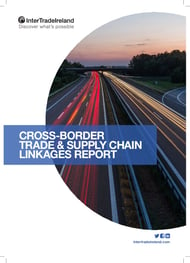Executive Summary
This paper examines the patterns of cross-border trade on the island of Ireland, focusing on the role of supply chain links, measured by the extent of trade in intermediate products and the contribution to overall trade of two-way trading firms (those simultaneously importing and exporting). We use detailed firm-level trade records to examine the composition, specialisation and dynamism of trading firms. This data is provided by the Central Statistics Office (CSO) and is based on detailed statistics on merchandise exports and imports of manufacturing firms. A number of case studies on specific firms are also included to illustrate the empirical patterns. The analysis is motivated by the key role that trade plays in overall economic performance across both parts of the island and, in the more immediate policy context of potential changes in the trading environment posed by the UK exit from the EU, by the importance of understanding and quantifying the cross-border linkages both in terms of direct trade in final products and also
in firms’ supply chains.
The key findings of the analysis are:
- Cross-border trade links show a high degree of integration: Northern Ireland accounts for between ten and twelve percent of total exports from Ireland to the UK and accounted for seven to eight per cent of imports. Given that the population of Northern Ireland makes up less than three per cent of the UK total, this shows the closeness of the economic ties between the two jurisdictions. Furthermore, previous work by InterTradeIreland (2009, 2011) suggested that the level of trade integration has the potential to be even stronger.
- Trade in intermediate products and the large role of two-way traders shows that supply chain links are a major element of cross-border trade. We find that a very significant share of cross-border trade is accounted for by firms that trade simultaneously in both directions. These two-way traders make up around 18 per cent of firms in our sample but accounted for over 60 percent of exports and over 70 per cent of imports in 2015. The share of intermediates in imports from Northern Ireland to Ireland is higher in almost all sectors than trade in the same sectors from the rest of the UK. Using more detailed firm level data shows that a majority of cross-border trade occurs in intermediate inputs and highlights the considerable level of interconnectedness of cross-border supply chain integration.
- Cross-border traders continuously adjust their products, showing evidence of flexibility and innovation. There is a high level of ongoing product turnover amongst trading firms with regular introductions of new products and considerable levels of product experimentation with many products traded for one year only. This pattern is consistent across firm size categories and between food and non-food firms, although larger firms are more likely to be simultaneously adding, dropping and trying out one-year products in any given year. This shows a high degree of dynamism and innovation amongst cross-border traders which will be particularly important in terms of their adaptability to potential post-Brexit changes in the trading environment.
You can download a full copy of the Cross-border trade and supply chain linkages report.
Select this link to give us a few details about yourself and we will send you the report instantly.
Visit the InterTradeIreland Cross-Border Trade Hub for up-to-date information about Trade Routes and Customs Paperwork and Supply Chain and Supplier Relationships.

